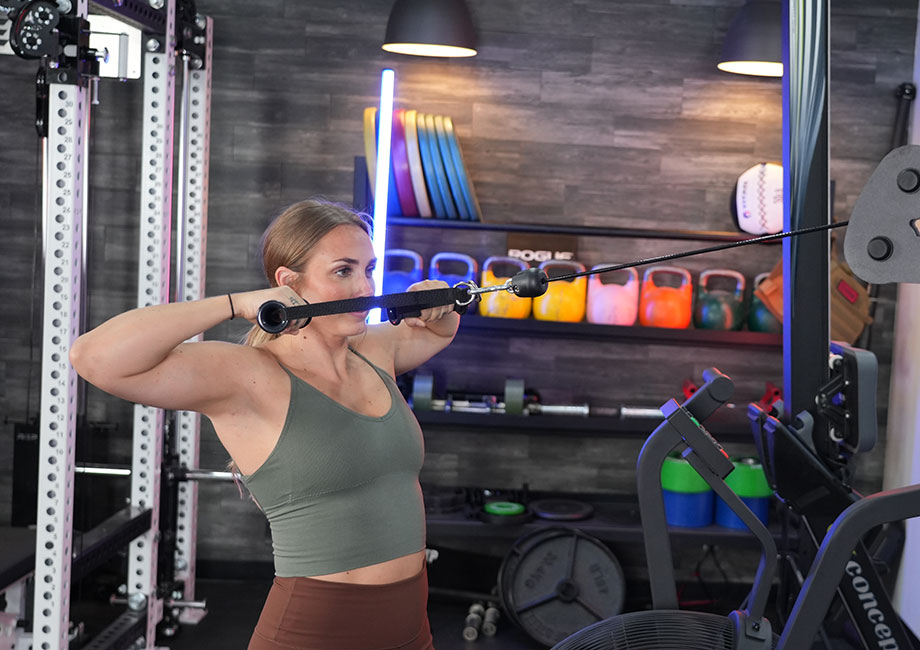We test and review fitness products based on an independent, multi-point methodology. If you use our links to purchase something, we may earn a commission. Read our disclosures.
When thinking of exercises for building bigger shoulders, the first two that probably jump to mind are the overhead press or dumbbell shoulder press. I’m a huge fan of both of these deltoid exercises, but as a certified personal trainer (CPT), I have a problem.
What’s the problem? Although both target the side and front delts (as well as the triceps) to a great extent, they don’t effectively hit the rear delts. For me, your shoulder workout isn’t done unless it includes specific rear-delt training. Doing so not only helps give you more complete shoulders but can improve your posture, too. This is because the rear delts work with other muscles in your back to prevent your shoulders from hunching forward, which is especially important if you spend long hours at a desk each day.
RELATED: Office Workout: 16 Trainer-Approved Desk-Friendly Exercises
I’ll explain the anatomy of the deltoids, and then run you through how to perform the nine best rear delt exercises along with the benefits of activating your rear delts in the first place.
9 Best Rear Delt Exercises
Let’s dive straight into the best rear delt exercises and how to perform them:
Face Pull
Why do it: Face pulls are a great exercise to isolate the rear delts. With a relatively light weight, you’ll set your rear delts on fire after a few sets. Experiment with different starting positions on the pulleys to target your rear delts in a slightly different way.
How to do it:
- Fix a rope attachment (or band) to one side of a cable machine. Position the pulley so it’s at either shoulder or head height.
- Choose your desired weight before taking hold of the rope with an overhand grip (palms facing the floor).
- To create tension, take a few steps away from the cables. Your feet should be flat on the floor and shoulder-width apart.
- Retract your shoulder blades, engage your core and glutes, and pull the rope toward your forehead.
- Pause, then return the rope to its original position.
- Continue for reps.
RELATED: Cable Shoulder Workouts
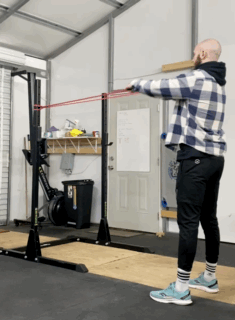
Dumbbell Reverse Fly/Rear Delt Fly
Why do it: Dumbbell reverse flyes isolate the rear deltoids, which is why they’re a popular shoulder exercise. You’ll need to use a lighter weight and focus on taking it slow to feel the mind-muscle connection1. Aside from a pair of dumbbells, you don’t need any other equipment, which is why I recommend them.
How to do it:
- Stand tall with a pair of dumbbells, one in each hand. Your arms should be resting at your sides.
- Keeping your back straight, bring your hips back and bend at your knees so your torso is at a 45-degree angle. Brace your core here.
- With a slight bend in your elbows, lift the dumbbells laterally until your hands are at shoulder height. Squeeze your shoulder blades
- Return the dumbbells to their starting position in a controlled manner.
- Repeat for the desired number of repetitions.
Expert tip: This exercise uses dumbbells, but you can also do a machine variation using the chest fly machine by facing the weight stack instead of facing away. A 2015 study by the Journal of Sports Medicine and Physical Fitness2 found that the reverse pec deck recruits the posterior delts to a greater extent compared to seated rows and lat pulldowns.
RELATED: Best Dumbbells
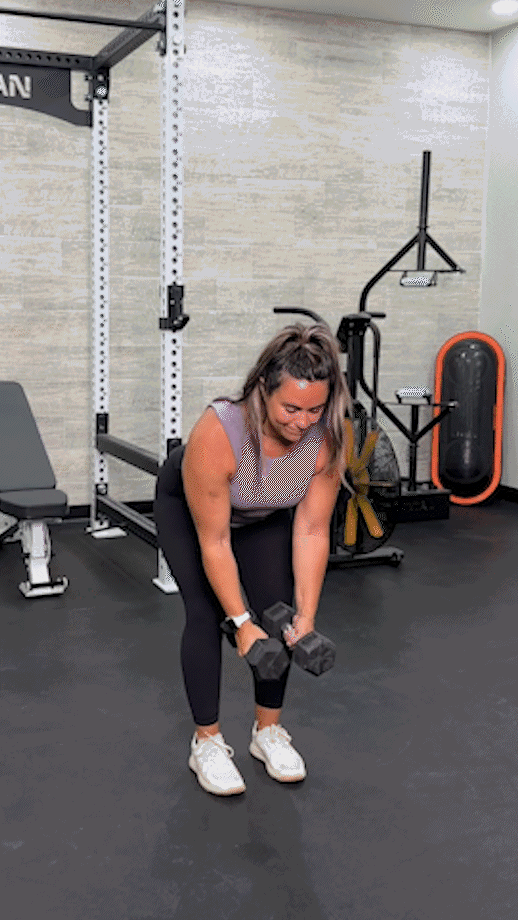
Single-Arm Bent-Over Row
Why do it: Although the single-arm dumbbell row doesn’t isolate the rear delts in the same way as a face pull or a dumbbell reverse fly, the benefit is that you’ll be able to lift heavier weights. Because you train one arm at a time, you may strengthen and correct muscular imbalances in the rear delts, too.
How to do it:
- On a flat bench, put down your right knee and right hand. You’ll start this exercise using your left hand.
- Add some of your body weight to stabilize yourself. Place your left foot flat on the floor with your toes facing forward and a slight bend in your knee.
- Pick the dumbbell slightly off the floor with your left hand, keeping your left arm straight to get a full range of motion.
- Brace your core, keep your head neutral, and then row the dumbbell toward your left hip. Pause.
- Slowly lower the dumbbell to the hanging position.
- Row for reps, then switch over to the right hand.
RELATED: Unilateral Exercises
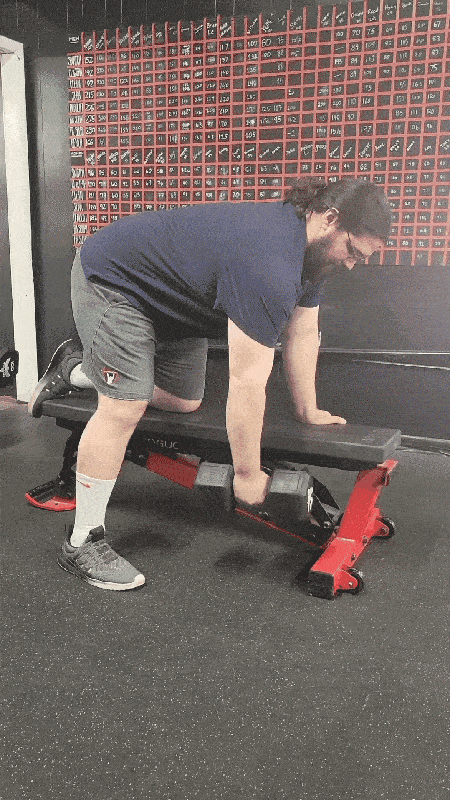
Wide-Grip Pull-Up
Why do it: If muscle growth in the back of your shoulders and improving grip strength are your goals, then adding wide-grip pull-ups to your workout routine is the move. Grip strength can help you get stronger at the other rear delt exercises, and you’ll be utilizing your bodyweight to do it.
How to do it:
- Step under the pull-up bar. Grab the handles with a wide, overhand grip (palms facing away from you).
- Lift your feet off the ground to get into the dead hang position, keeping your chest up and core activated.
- Looking toward the handles, pull yourself up. You’ll want to focus on the activation of your back muscles, rather than your biceps.
- When your chin clears the bar, pause before lowering yourself down.
- Continue for the desired number of reps.
Expert tip: For some people, wide-grip pull-ups may be too difficult. Instead, you can try inverted rows (which you’ll see below), or use a resistance band to do banded pull-ups.
RELATED: Best Resistance Bands
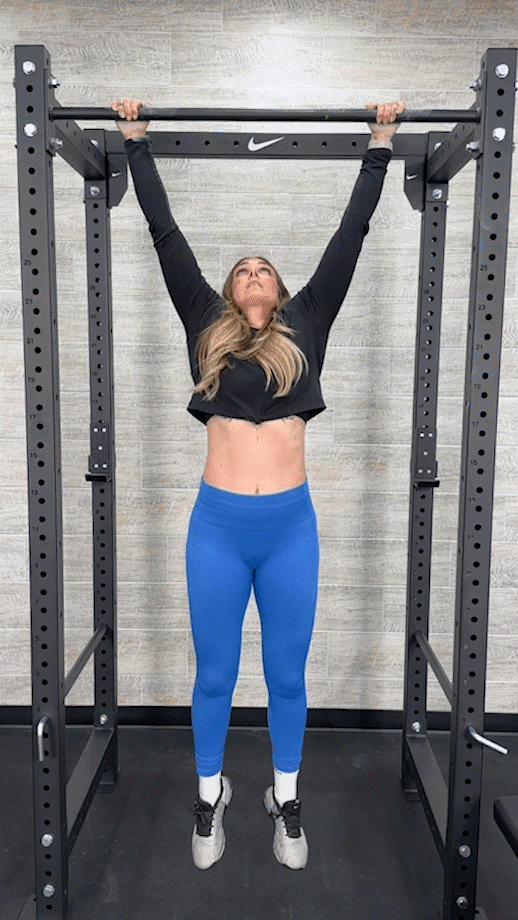
Bent-Over Barbell Row
Why do it: With bent-over barbell rows, you’ll be able to lift heavier weights compared to isolation exercises such as face pulls and dumbbell reverse flyes (which you saw above). Lighten the load and use a wider grip to effectively target your rear delts.
How to do it:
- With the bar on the ground, add the necessary weight plates.
- Similar to a deadlift, get underneath the barbell so it’s covering your shoelaces. Hinge at your hips to take hold of the bar with an overhand grip (palms facing the floor).
- Keeping your chest up and core braced, deadlift the bar until you’re standing tall. If needed, adjust your feet shoulder-width apart.
- Push your hips backward so the bar is near your knees to get into the starting position.
- Row the barbell toward your abdominal region, tucking your elbows in as you do so. Hold for a moment before returning the bar to its original position.
- Keep going for repetitions.
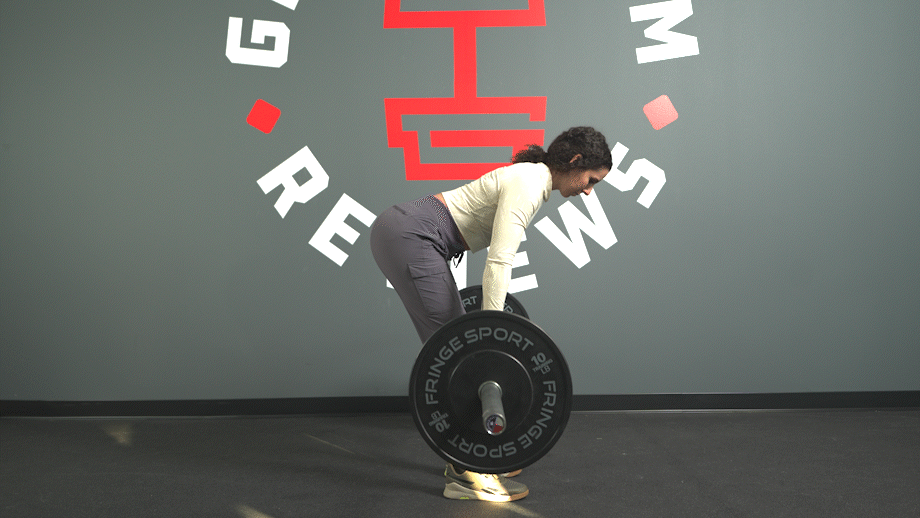
Inverted Row
Why do it: I love inverted rows because you’re doing rear delt training using your bodyweight only, which makes it an effective exercise for those who don’t have much equipment. It’s important to take a wider grip with this exercise and ensure your elbows finish to the sides to hit your rear delts to a greater extent.
How to do it:
- Adjust a Smith machine so it’s at hip height. Alternatively, add J-hooks to a squat rack and position the bar at the same height (either one works for this exercise).
- Sit down on the floor underneath the bar. Take hold of it with an overhand grip, ensuring that your arms are in a straight line, perpendicular to the bar.
- Walk your feet out until you’re comfortable. Note: the straighter your legs, the more difficult the movement will be.
- Activate your core and pull your chest towards the bar, only focusing on using your upper body.
- Pause before lowering yourself back down.
- Repeat for reps.
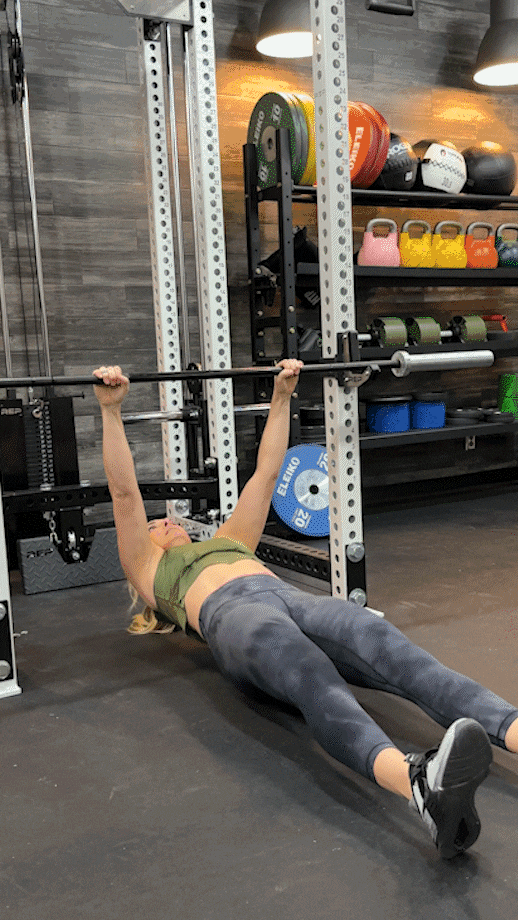
Arnold Press
Why do it: The Arnold press works all three deltoid muscles (posterior deltoid, lateral deltoid, and anterior deltoid). The movement is similar to a dumbbell shoulder press but with an added twist for an extra challenge. Instead of stopping at your ears, you’ll continue the motion until the dumbbells are in front of your shoulders. The external rotation element helps work your rear delts, too.
And yes, this move is credited to the Terminator himself—Arnold Schwarzenegger.
How to do it:
- Stand upright with your feet hip-width apart, taking hold of a pair of dumbbells. Position them in front of your shoulders, with your palms facing toward you.
- Engage your core and glutes, and then press the dumbbells overhead. You’ll want to rotate them as you do so until your palms face away from your body.
- When your arms are extended, pause. Slowly return the dumbbells to the starting position, reversing the rotation.
- Press for repetitions.
Expert tip: Although this is the standing version of the Arnold Press, you can also do it seated. I prefer the latter, but every individual is different so try both to see what works.
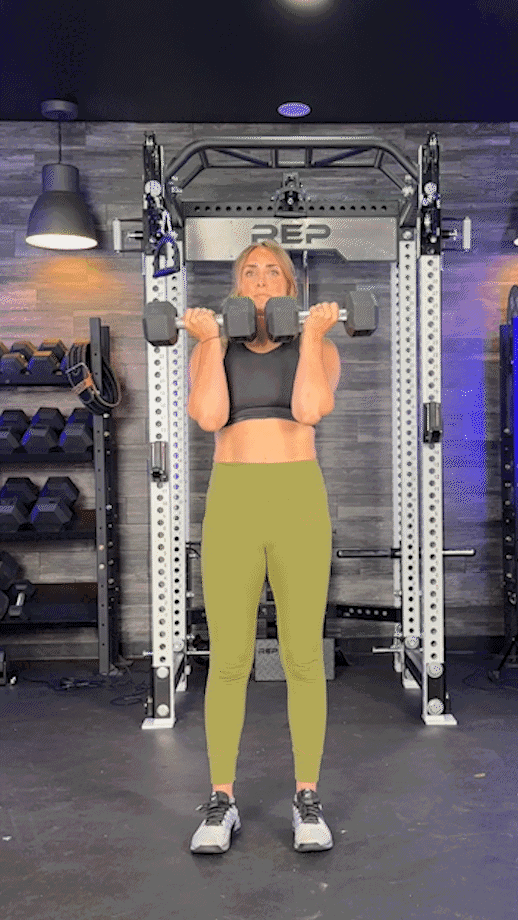
Upright Row
Why do it: The upright row is easy to learn and is extremely versatile because they can be performed using barbells, dumbbells, kettlebells, or cables. A 2013 study by the Journal of Strength and Conditioning Research3 found that a wider grip should be used by those seeking to maximize the involvement of the deltoid and trapezius muscles during the upright row.
How to do it:
- Hold a barbell with an overhand grip, standing tall with your feet shoulder-width apart. The bar should be positioned at your pelvic region.
- Retract your shoulder blades, brace your core, and then pull the bar toward your shoulders. You’ll want to keep the bar close to your body.
- Pause at the top of the movement before bringing the bar down in a controlled manner.
- Continue for the desired number of repetitions.
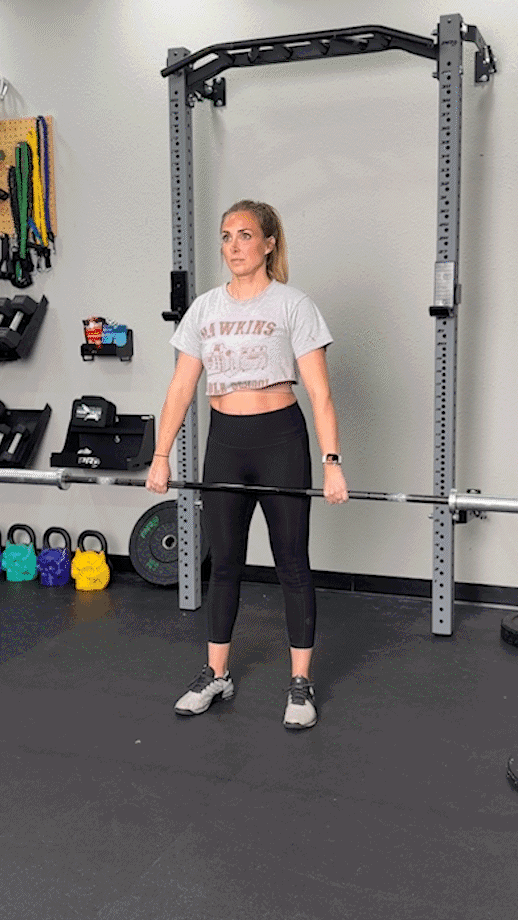
Wide-Grip Lat Pulldown
Why do it: Regularly doing wide-grip lat pulldowns can help with hypertrophy of the rear delts and may get you stronger at other rear delt exercises on this list, including pull-ups, inverted rows, and bent-over barbell rows.
Your hand position is important, as shown in a 2002 study by the Journal of Strength and Conditioning Research4. To target the rear delts, bringing the attachment to the front of your body is more effective than finishing behind your head. But, you could also try a supinated or close grip to see how that feels.
How to do it:
- Choose your desired weight, then take hold of the attachment with an overhand grip (palms facing away from you).
- Sit down with your head neutral and chest up, securing your knees underneath the pad.
- Lean back slightly, and pull the attachment toward your upper chest. You’ll want to focus on using your lats rather than your biceps here.
- Pause, then slowly return the attachment to its original position.
- Repeat for reps.
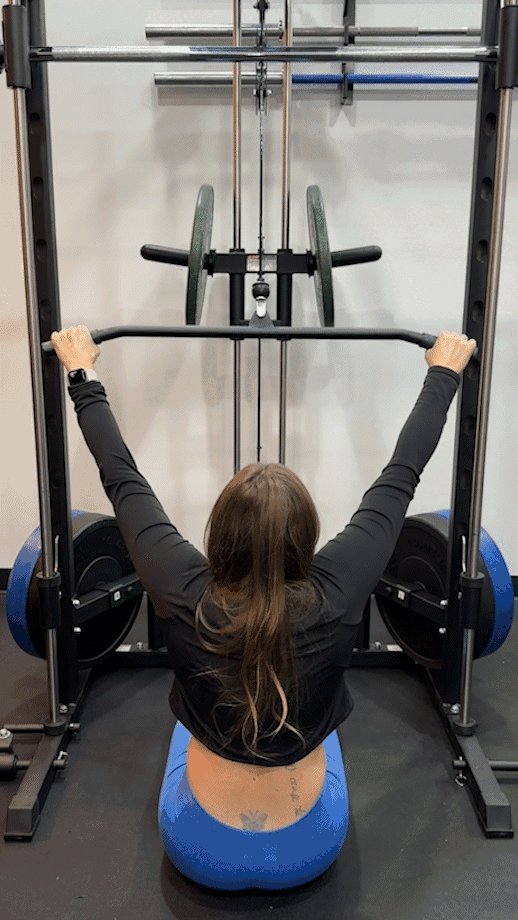
Best Rear Delt Workouts to Try
Okay, I know you’re itching to get started. Before you do, here are the three best rear delt workouts that I recommend for three different fitness goals:
Best Rear Delt Workout For Beginners
For this beginner rear delt workout, I’m going to primarily focus on using machines to get you accustomed to rear delt training:
| Exercise | Sets | Reps |
| Arnold Press | 3 | 8 |
| Wide-Grip Lat Pulldown | 3 | 10 |
| Face Pull | 2 | 12 |
Expert tip: If your gym has a rear delt machine, feel free to swap the face pulls for rear delt flyes instead.
Best Rear Delt Workout For Hypertrophy
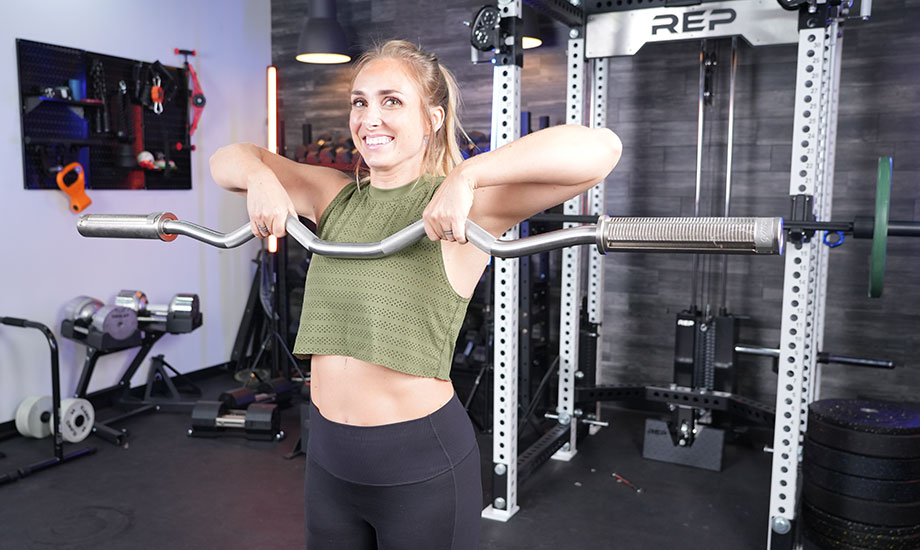
To build muscle in your rear delts, I’m going to step it up a notch. The number of sets will increase, as will the difficulty of the exercises:
| Exercise | Sets | Reps |
| Wide-Grip Pull-Up | 3 | 6 |
| Bent-Over Barbell Row | 3 | 8 |
| Upright Row | 3 | 10 |
| Dumbbell Reverse Fly | 2 | 12 |
Expert tip: You’ll want to find a weight that’s relatively easy for the first few reps but challenging at the end. If you can’t do wide-grip pull-ups, do banded pull-ups or inverted rows instead.
Best Bodyweight Rear Delt Workout
To train your rear delts using your bodyweight only, I’ve got you covered. Superset the following two exercises for five sets in total:
| Exercise | Sets | Reps |
| Wide-Grip Pull-Up | 5 | 6 |
| Inverted Row | 5 | AMRAP (as many reps as possible) |
Expert tip: After the pull-ups, go straight to inverted rows without resting. Trust me, your rear delts (as well as muscles in your upper back and biceps) will be on fire after this bodyweight rear delt workout.
RELATED: At-Home Bodyweight Workout
Anatomy of the Deltoids
Before we dive into the best rear delt exercises, let’s talk about delt anatomy. The deltoid5 is a triangular muscle, and its base attaches to the spine of the scapula and lateral third of the clavicle5. There are three distinct parts with varying.
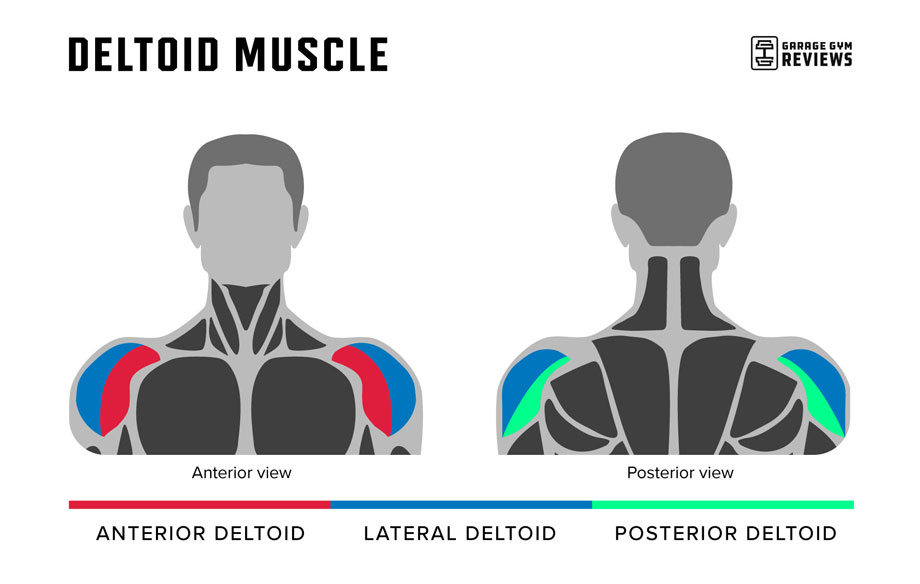
See below for what these are and their functions:
Posterior (Rear) Delts
The posterior deltoid is located on your upper back and contracts simultaneously with the other two delts (lateral and anterior) to abduct the arm past 15 degrees. More specifically, it stabilizes your arm when you raise your arms to the sides. Furthermore, it works with the latissimus dorsi to extend the arm during ambulation (or movement).
Lateral (Side) Delts
During abduction, the lateral delts are responsible for raising your arm from 15 to 100 degrees.
Anterior (Front) Delts
Although the anterior delts are also also responsible for stabilizing your arm during abduction, it has another function. It works with the pectoralis major to flex your arm when walking.
Benefits of the Best Rear Delt Exercises
Next, I’ll cover what I believe to be the top three benefits of training your rear delts:
Builds Boulder Shoulders
If you build muscle in the rear delts, you’ll likely notice an improvement in the appearance and shape of your shoulders. As I mentioned, the overhead and dumbbell shoulder press are great but don’t target the rear delts as effectively. Adding the best rear delt exercises can give your shoulders a more complete look.
May Improve Posture
We spend a lot of time at our desks or watching television. Unfortunately, this can lead to poor posture. Improving the health of your shoulder joints by including rear delt exercises can help to combat this, reducing the risk of injury or pain. Many exercises in the gym focus on the lateral and anterior delts, but the rear delts are just as important.
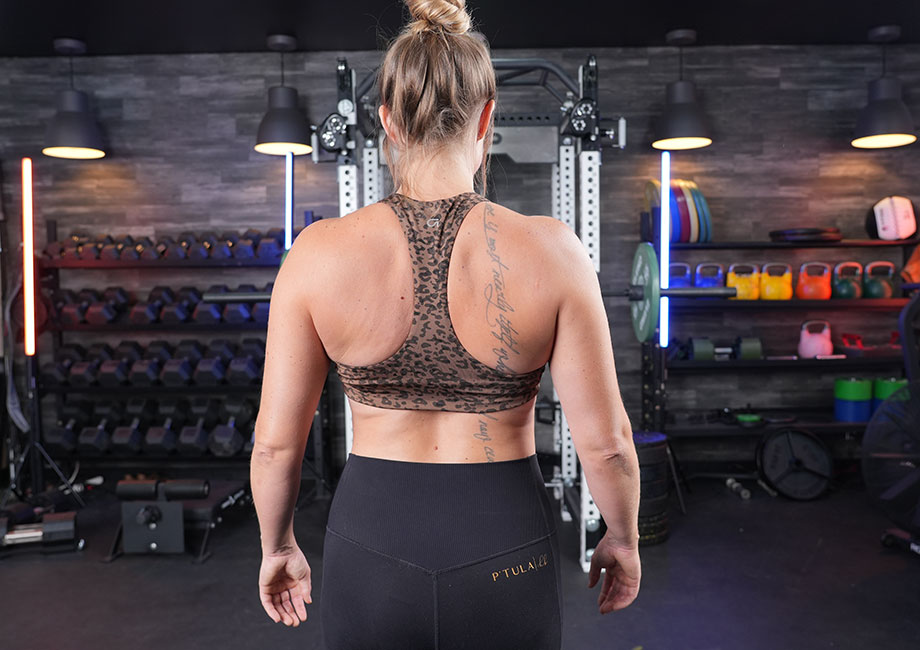
RELATED: Office Workout: 16 Desk-Friendly Exercises
Helps With Other Lifts
Consistently doing rear delt exercises may help you get stronger at other lifts in the gym. Compound exercises such as pull-ups, rows, dumbbell shoulder presses, and more use the rear delts. If you’re including some of the best rear delt exercises into your training program for the first time, you may notice a significant improvement right away.
Best Rear Delt Exercises: Final Thoughts
I appreciate that the rear delts aren’t the biggest muscle group in the body. However, there are several reasons why you should focus on training them, including hypertrophy of the shoulders, improved posture, and getting stronger at other lifts in the gym.
To review, here are my nine best rear delt exercises for you to try:
- Face Pull
- Dumbbell Reverse Fly/Rear Delt Fly
- Single-Arm Bent-Over Row
- Wide-Grip Pull-Up
- Bent-Over Barbell Row
- Inverted Row
- Arnold Press
- Upright Row
- Wide-Grip Lat Pulldown
Best Rear Delt Exercises: FAQs
How can I target rear delts?
To target the rear delts, try adding some of the following exercises to your exercise routine: face pulls, dumbbell reverse fly, single-arm bent-over row, wide-grip pull-up, bent-over barbell row, inverted row, Arnold press, upright row, and wide-grip lat pulldown.
Try out a few and see what you prefer.
Do I need to go heavy on rear delts?
You don’t always need to go heavy on rear delts. It will depend on the exercise you’re doing. For isolation exercises (such as face pulls and dumbbell reverse fly), go light and focus on your form and the mind-muscle connection. On compound exercises that activate more muscle groups than just the rear delts, go heavier (while still focusing on your form).
Are high reps better for rear delts?
High reps are better for rear delts if muscular endurance is your goal. If this is the case, then yes, aim for 15 or more reps each set. For those looking for muscular hypertrophy (i.e. to build muscle) in the rear delts, go for between six and 12 reps. I wouldn’t recommend going any lower than six reps on rear delts.
RELATED: How Many Reps to Build Muscle?
Are rear delt flyes effective?
You bet they are. Rear delt flyes are one of the most effective rear delt exercises, and for good reason. Although you can do these with dumbbells, you can use the cables, too. There’s also a machine in most gyms that replicates the movement (it’s usually a chest fly machine, but you sit facing the weight stack rather than away from it).
References
- Calatayud J, Vinstrup J, Jakobsen MD, Sundstrup E, Brandt M, Jay K, Colado JC, Andersen LL. Importance of mind-muscle connection during progressive resistance training. Eur J Appl Physiol. 2016 Mar;116(3):527-33. doi: 10.1007/s00421-015-3305-7. Epub 2015 Dec 23. PMID: 26700744.
- Franke Rde A, Botton CE, Rodrigues R, Pinto RS, Lima CS. Analysis of anterior, middle and posterior deltoid activation during single and multijoint exercises. J Sports Med Phys Fitness. 2015 Jul-Aug;55(7-8):714-21. Epub 2014 Jun 20. PMID: 24947920.
- McAllister MJ, Schilling BK, Hammond KG, Weiss LW, Farney TM. Effect of grip width on electromyographic activity during the upright row. J Strength Cond Res. 2013 Jan;27(1):181-7. doi: 10.1519/JSC.0b013e31824f23ad. PMID: 22362088.
- Signorile JF, Zink AJ, Szwed SP. A comparative electromyographical investigation of muscle utilization patterns using various hand positions during the lat pull-down. J Strength Cond Res. 2002 Nov;16(4):539-46. PMID: 12423182.
- Elzanie A, Varacallo M. Anatomy, Shoulder and Upper Limb, Deltoid Muscle. [Updated 2023 May 8]. In: StatPearls [Internet]. Treasure Island (FL): StatPearls Publishing; 2023 Jan-. Available from: https://www.ncbi.nlm.nih.gov/books/NBK537056/
Further reading

When you’re ready to build a rock-solid core, look no further than this trainer-recommended hollow hold workout. Read more

The BAMF Hammer is a great option for anybody looking to add some variety to the routine by increasing overall strength and flexibility. Being hand-made in the U.S. the hammer will humble all who dare to pick it up. It also looks really cool and can make anyone feel like Thor. Read more

When thinking of exercises for building bigger shoulders, the first two that probably jump to mind are the overhead press or dumbbell shoulder press. I’m a huge fan of both of these deltoid exercises, but as a certified personal trainer (CPT), I have a problem.What’s the problem? Although both target the side and front delts (as well as the triceps) to a great extent, they don’t effectively hit the rear delts. » Read more about: Add These 9 Best Rear Delt Exercises For Bigger Shoulders And Improved Posture » Read more

Whether you’re a first-timer or looking to get faster, our marathon training plans and guide from avid runners can help you reach your running goals. Read more

